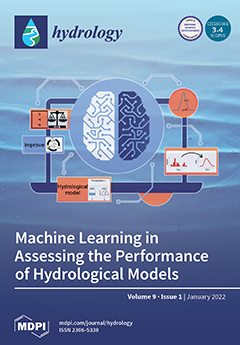Rainfall and temperature trends detection is vital for water resources management and decision support systems in agro-hydrology. This study assessed the historical (1983–2005) and future (2026–2100) rainfall, maximum temperature (T
max), and minimum temperature (T
min) trends of the Ziway Lake
[...] Read more.
Rainfall and temperature trends detection is vital for water resources management and decision support systems in agro-hydrology. This study assessed the historical (1983–2005) and future (2026–2100) rainfall, maximum temperature (T
max), and minimum temperature (T
min) trends of the Ziway Lake Basin (Ethiopia). The daily observed rainfall and temperature data at eleven stations were obtained from the National Meteorological Agency (NMA) of Ethiopia, while simulated historical and future climate data were obtained from the Coupled Model Intercomparison Project 5 (CMIP5) datasets under Representative Concentration Pathways (RCP) of 4.5 and 8.5. The CMIP5 datasets were statistically downscaled by using the climate model data for hydrologic modeling (CMhyd) tool and bias corrected using the distribution mapping method available in the CMhyd tool. The performance of simulated rainfall, T
max, and T
min of the CMIP5 models were statistically evaluated using observation datasets at eleven stations. The results showed that the selected CMIP5 models can reasonably simulate the monthly rainfall, T
max, and T
min at the majority of the stations. Modified Mann–Kendall trend test were applied to estimate the trends of annual rainfall, T
max, and T
min in the historical and future periods. We found that rainfall experienced no clear trends, while T
max, and T
min showed consistently significant increasing trends under both RCP 4.5 and 8.5 scenarios. However, the warming is expected to be greater under RCP 8.5 than RCP 4.5 by the end of the 21st century, resulting in an increasing trend of T
max and T
min at all stations. The greatest warming occurred in the central part of the basin, with statistically significant increases largely seen by the end of the 21st century, which is expected to exacerbate the evapotranspiration demand of the area that could negatively affect the freshwater availability within the basin. This study increases our understanding of historic trends and projected future change effects on rainfall- and evapotranspiration-related climate variables, which can be used to inform adaptive water resource management strategies.
Full article





